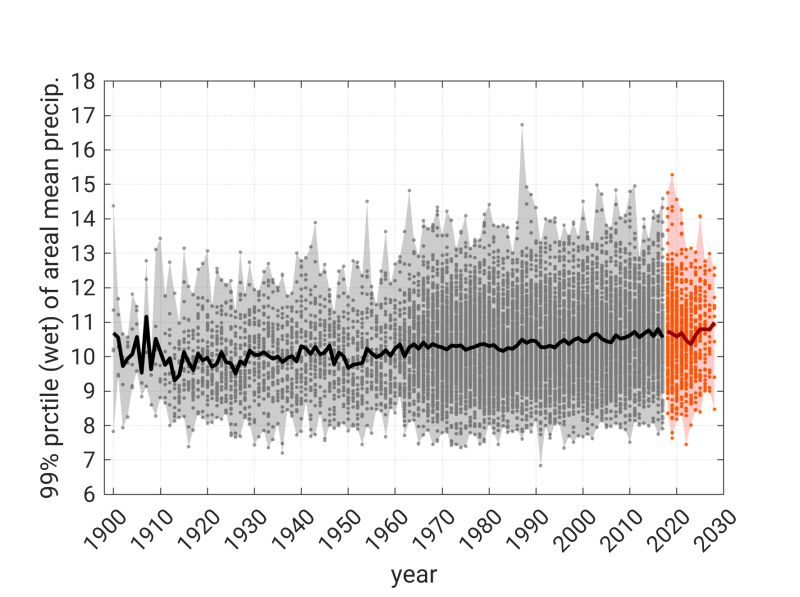LAERTES-EU: New regional climate model ensemble with high application potential
Extreme events such as heavy rain, severe floods, heat waves, or storms often lead to large impacts. Since each of these events is unique, a large number of such extremes is needed to understand the processes involved. However, such extreme events occur only very rarely. Suitable observation data, especially spatially distributed data, are only available for a few 10-year periods and are therefore not sufficient for a comprehensive study of the frequency and potential intensity of such extremes.
This shortcoming can be addressed for example with so-called weather generators to generate synthetic events, or by considering a large ensemble of simulations of numerical weather or climate models. The second variant also includes the new LAERTES-EU Ensemble (LArge Ensemble of Regional climaTe model Simulations for EUrope), which consists of over 1000 simulations with about 12000 simulation years using the regional climate model COSMO-CLM [1]. The setup of the regional model is kept unchanged, but driven with different boundary data (e.g., different global model simulations), which leads to slightly different temporal evolution but consistent long-term trend each time, thus covering the physically possible range of events. LAERTES-EU is part of the comprehensive simulation ensemble for decadal climate prediction created in the MiKliP project (Medium-Term Climate Forecasts [2]). With this ensemble, the last 60 years are covered by a large number of simulations. To further increase the quality of the model data, some post-processing (such as bias correction) was performed to minimize systematic differences between model and observations.
The LAERTES-EU ensemble can be used for various research interests but also for applications beyond. The large ensemble size allows the statistically robust determination of even comparatively small variations and signals. For example, Figure 1 shows an estimate of the long-term trend for the strongest 1% of precipitation in Central Europe (99th percentile) [1]. Although the individual members of the ensemble vary considerably, a long-term increase in the ensemble mean over the last 120 years can be identified. Since most of the members show the same tendency, this is statistically significant, i.e., highly likely. Overall, the analyses show that LAERTES-EU exhibit realistic variability on different time scales and in frequency distributions.
The LAERTES-EU is currently being used as input data for hydrological runoff simulations to quantify the flood risk in different rivers and countries [3]. Such risk analyses are of great importance in the insurance industry. Another application is the ClimXtreme project [4], which currently investigates how the frequency, intensity, and duration of extreme events of all kinds have developed in the past and what further development can be expected in the future. In addition, the RegIKlim/NUKLEUS project [5] aims to prepare climate model data in such a way that users from a wide variety of fields (hydraulic engineering, forestry, urban development, etc.) can use them in a targeted and direct manner.

References:
[1] Ehmele, F.; Kautz, L.-A.; Feldmann, H.; Pinto, J. G. (2020): Long-term variance of heavy precipitation across central Europe using a large ensemble of regional climate model simulations. Earth System Dynamics, 11(2), 469-490, https://doi.org/10.5194/esd-11-469-2020
[2] Marotzke J., et al. (2016): MiKlip – a National Research Project on Decadal Climate Prediction. Bull Amer Meteorol Soc, 97:2379–2394. https://doi.org/10.1175/BAMS-D-15-00184.1
[3] Ehmele, F.; Kautz, L.-A.; Kadlec, M.; He, Y.; Lentink, H. S.; Feldmann, H.; Manful, D.; Kelemen, F. D.; Ludwig, P.; Pinto, J. G.: Adaptation and Application of the LAERTES-EU Data set for Hydrological Issues and Catastrophe Modeling, Hydrology and Earth System Science, (in preparation)
[4] https://www.climxtreme.net/
[5] https://www.fona.de/de/massnahmen/foerdermassnahmen/RegIKlim/nukleus.php
Florian Ehmele, AG “Regional Climate and Weather Hazards”
